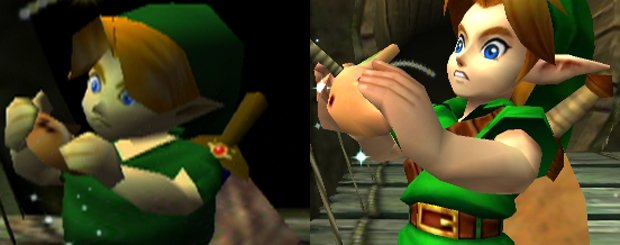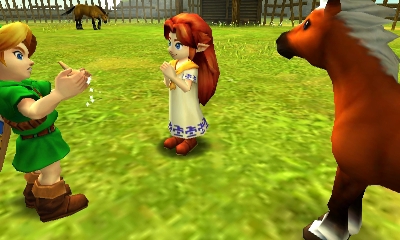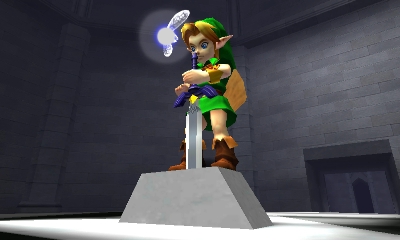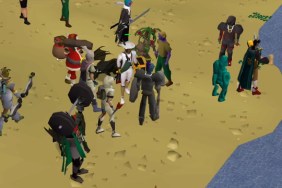It bears repeating: Without a fairy, you’re not even a real man.
First, a history lesson about myself (boy, if that sentence doesn’t make me feel old): I was 13 when the original Ocarina of Time was released. I made my dad drive me to Toys"R”Us immediately after school to pick up my copy (pre-ordered long ago, of course). What then followed is one of my more ridiculous gaming stories.
I played through the game, beating it within a week. After the last enthralling moment, I sat in front of my TV, momentarily puzzled over what I could possibly do now that was worthy of following such an experience. The only thing I could come up with? Play it again. The second time I hit the credits, I ran into the same conundrum. So I played it again. And again. And again.
I played through OoT five times before I even touched another game. Over the next few years I’d do it four more times, then once more when the Master Quest was released. And now with the 3D version, you can add another one to the tally. I guess what I’m trying to say is: I’ve had an unhealthy obsession with this game (and it’s not even my favorite Zelda, either). Yeah, I know where all 100 gold skulltulas are from memory. Big whoop, wanna fight about it?
Normally, when a game is updated and re-released, you’d expect an assortment of bells and whistles thrown in to justify a new purchase. And normally, a lack of said extras would reflect negatively on the grade. But we’re talking about a game that is widely considered to be The Greatest of All-Time—in this case, every little tweak or added dressing to the package is another risk Nintendo takes of separating you from the core experience that gave OoT its legendary reputation in the first place.
And that’s why, after all this time, they’ve managed to impress me all over again. Not because the game is great—which it is—honestly, who wouldn’t see that coming? But because of the way Nintendo has deftly ridden the paper-thin line between adding just enough to make the adventure fresh and exciting and not overshadowing the brilliance of the original in any way, shape, or form.
So on to the changes we go; there aren’t many, but they are significant nonetheless. The graphics are of course the most immediately noticeable, although the update still manages to be rather subtle about it. It’s not like you’ll start up a new game and be floored by how amazing it looks now—but rather, you’ll stop and marvel for a moment as a character here and a building there jogs your memory and makes the difference between versions all the more apparent. If you never played the original, then it’s just going to come off as a nice-looking 3DS game with some age clearly visible in the textures and models.

The characters are the most improved, Link especially. Whereas they once looked like mannequins with painted-on faces, they now at least have actual definition to their features. But beyond the graphical touch-ups, there’s thankfully been absolutely no meddling like, for instance, an effort to make overly epic cut-scenes à la Metal Gear Solid: The Twin Snakes. Every single frame is the same, shot-for-shot—just a little prettier, like wiping away the grime and dust that’s accumulated on your 13-year old Porsche. Yes, Zelda is a sports car in this analogy.
The 3D is balanced perfectly, right in a nice, comfortable spot between the intense, bordering-on-painful effect in Rayman 3D and the almost nonexistent 3D in Splinter Cell. I was able to keep the slider in the middle the whole way through and enjoy the game, sometimes even feeling like the 3D was actually adding something, enhancing the imposing majesty of the Temple of Time or the feeling of riding at full speed on Epona. And hey, if nothing else, I’ve discovered that 3D has made lens flares look cool again for the first time since… Ocarina of Time.
Button assignments are the only place where OoT 3D is arguably less optimal than the original, which is an unavoidable consequence of simply having less buttons. You can map two items to X and Y, down from the original three. They tried to make up for it, however, by giving you an additional two slots that you can access by touching boxes on the touchscreen, giving you a net result of more item shortcuts with a slightly less intuitive interface. On the plus side, the ocarina has been given a special touch screen box so it’s always available without imposing upon your other item shortcuts.

The addition that I’m most happy with is, ironically, the one that I thought was most pointless going in—gyroscopic aiming. You can still use the circle pad to aim projectile weapons, and at first, that’s what you’ll instinctively do. After a few minutes, however, aiming by physically moving the 3DS will suddenly feel more natural, and using the old analog method feels like going back from automatic to stick shift (last car analogy, I swear).
Last (and least) of the immediate changes are the Sheikah stones which have been added all around the world. You can visit these stones whenever you’re stuck in a dungeon or at a loss for how to proceed to your next destination, and they have an expansive collection of short videos that show you exactly what you need to do to solve pretty much every significant puzzle in the game. It’s utterly useless fluff for an OoT vet or anyone who likes to find their own way, but could prove useful to new players who don’t mind a helping hand… err… eye. They’re entirely free to use, though; there ought to be some cost to getting a hint, even if it’s just a few rupees.
When the journey comes to a close, there are a couple additional modes to try out. The Master Quest has returned, and even if you finished it on the Gamecube, you might want to give it a try again. This Master Quest is a mirrored version of the whole game that also messes with the dungeon solutions. Not only that, but enemies hit much harder, making it likely that you'll actually use that slew of potions you carry around all the time.

Finally, there’s a boss attack mode, which keeps track of your best times against individual bosses and has an option of having you fight against a gauntlet of all the bosses in a row. It’s not an unwelcome addition, but considering how easy the bosses are, it’s also not as exciting as the same type of mode in harder games.
But hey—this is Ocarina of Time here. They could have given us the same exact game they did 13 years ago without anything added and it would still be in the 'A' territory (oh wait… they did). Ocarina of Time 3D adds enough that this version has a clear leg-up on its predecessor while still keeping the flawless adventure intact. Whether you’ve already played OoT to death or never experienced this masterpiece before, this game is still the premier reason to own a 3DS right now.
-
It’s Ocarina of Time, ‘nuff said
-
Subtle yet significant graphics update
-
Comfortable, good use of 3D
-
Gyroscopic aiming
-
More item shortcuts via the touch screen
-
Sheikah stones for whenever you get stuck
-
No gold game card? Come on, Nintendo!







